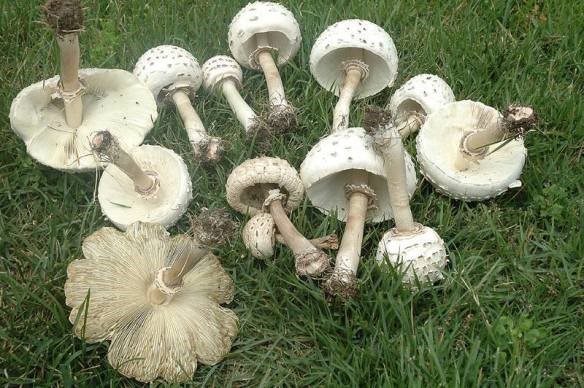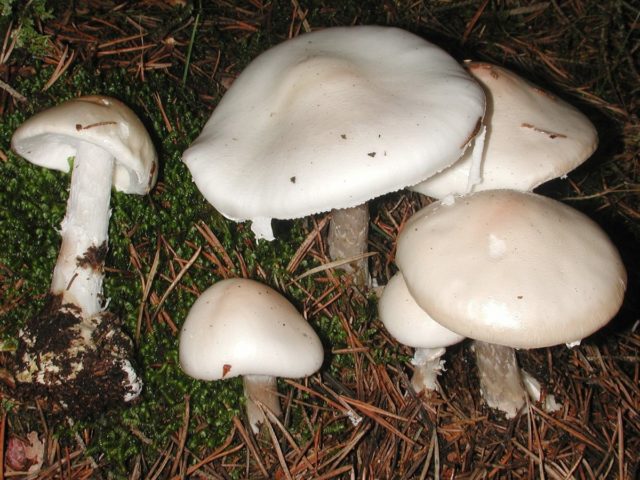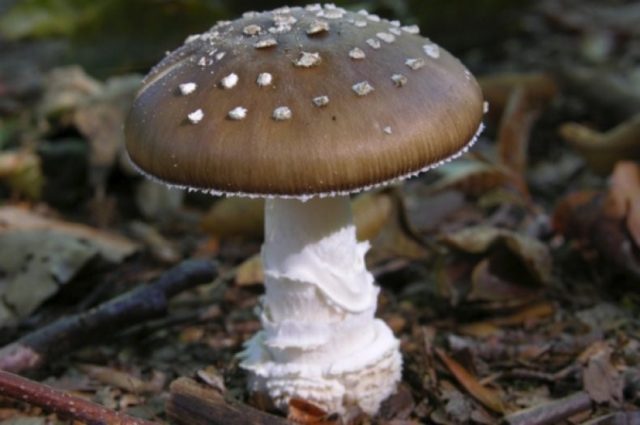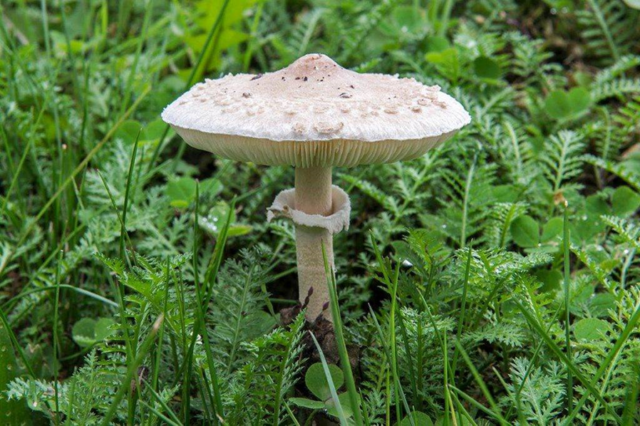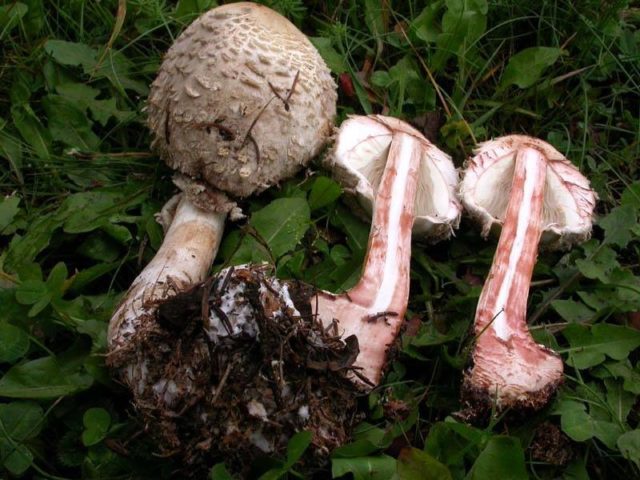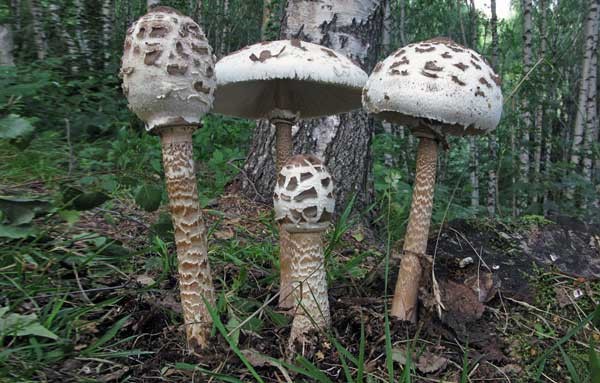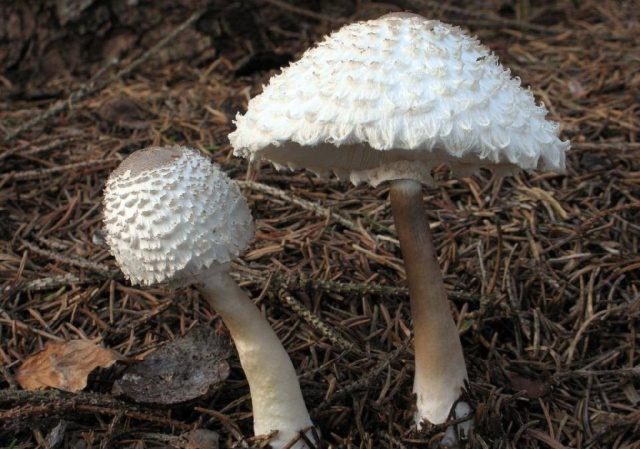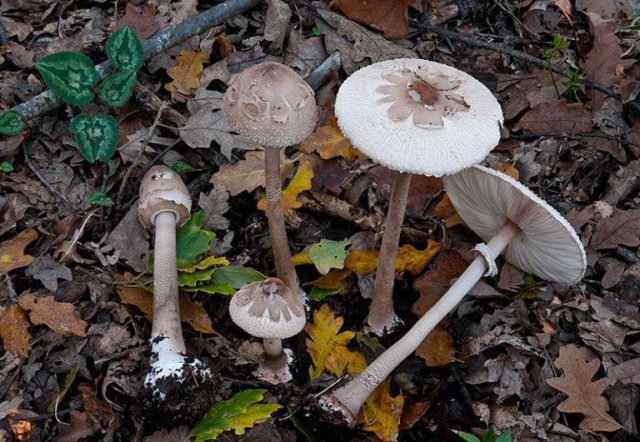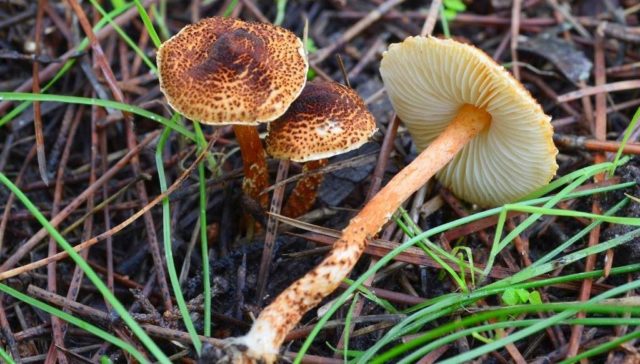Content
- 1 What can be confused with a mushroom umbrella
- 2 Types of edible umbrella mushrooms
- 3 What poison umbrellas look like
- 4 How to distinguish edible mushroom umbrellas from poisonous
- 5 What to do if you ate the poisonous twin of the umbrella mushroom
- 6 Tips from experienced mushroom pickers
- 7 Photo of poisonous mushroom umbrellas
- 8 Conclusion
Many mushroom pickers in the process of "quiet hunt" often meet on the side of highways, in groves and on the edges of mixed forests, unusual mushrooms with a long thin stem and a large flat cap, similar to a saucer. At first glance, they resemble a fly agaric or a pale toadstool. In fact, these mushrooms are called macrolepiots or umbrellas in the common people. They belong to the Champignon family and can be eaten raw. But not all of them are edible. Photos of poisonous mushrooms of umbrellas will help you not to make a mistake when collecting and make the right choice in the forest.
What can be confused with a mushroom umbrella
Almost all edible mushrooms have poisonous or false counterparts. Umbrellas are no exception. Some of their representatives are inedible, and they should be able to distinguish using the main external signs.
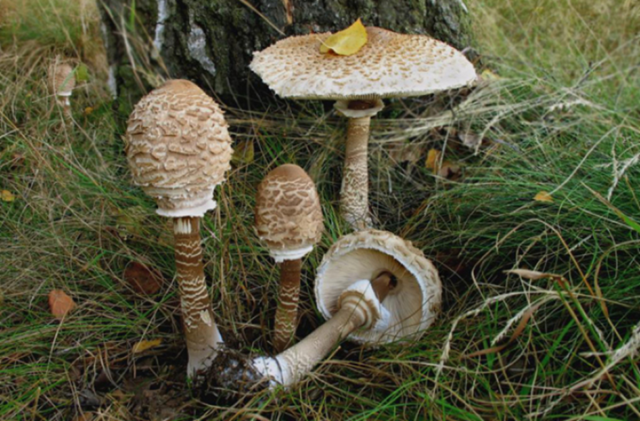
The edible umbrella mushroom is often confused with the poisonous pale toadstool.
Most often, umbrellas are confused with pale toadstools or inedible doubles. Poisonous mushrooms can be very similar to them in a number of external signs. By studying the characteristics of these species, you can learn to distinguish mushrooms that look like an umbrella in color, size and shape of the cap. And in no case collect fruiting bodies that cause even the slightest doubt:
- Chlorophyllum lead-slag - the poisonous twin of the umbrella. The size of the white cap with brown scales can be from 7 to 30 cm. The smooth leg is framed with a ring. The light flesh has a neutral taste and odor; if damaged, the color turns brown. The cut site turns slightly red. If you press on the plates, they will take on a yellow tint. Unlike real umbrellas, these doubles have a white leg darkening with age and acquiring a gray-green, sometimes olive color.
Poisonous umbrella mushrooms grow singly, rarely - "witch's rings"
- Chlorophyllum dark brown or brown has a fleshy cap, 10-15 cm in diameter, covered with brown scales. The pulp of the false umbrella mushroom, if damaged, changes color from white to orange-red. The leg of an adult poisonous twin is shorter and thicker than that of a real umbrella. It is smoother and has a tuber-like outgrowth reaching up to 6 cm in diameter. Also, a distinctive feature is the absence of a pattern on the stem.
Chlorophyllum dark brown differs from a real umbrella in its short stature
- White toadstool (stinky fly agaric). The poisonous twin has a very high toxicity. The difference between an umbrella mushroom and a toadstool lies in the surface of the cap. In the edible representative, it is covered with scales formed as a result of cracking of the skin. The cap of the white toadstool is smooth, white, sometimes with a gray tint.
If a stinky fly agaric is broken, its pulp will exude a very unpleasant odor.
- Amanita muscaria less like other brothers like an umbrella, but sometimes they are still confused. A fly agaric can be distinguished from an umbrella by a flat brown cap covered with scales. The leg is white, thickened below. The color of the poisonous pulp does not change when broken and is characterized by an unpleasant taste and smell.
The dark brown hat of the panther fly agaric with white flocculent patches betrays its poisonous origin.
Types of edible umbrella mushrooms
There are several edible umbrella mushrooms that have a delicious taste. Despite the external similarity, they have a number of differences:
- Umbrella mushroom (field, meadow). The size of a scaly matte cap reaches 7-13 cm. At a young age, it has a rounded shape, in the form of an egg. Growing up, it opens, becoming almost flat with a convex dark tubercle. The structure of the cylindrical stem is hollow. Outwardly, it looks slightly curved, white with a darker ring. Turns brown when damaged. Height reaches 5-14 cm. Grows from mid-June to early October in all countries of Eurasia, Australia and northern parts of Africa and America. It is especially popular in traditional Chinese cuisine.
The plates of young mushrooms are white, the old ones darken, the pulp is light with a pleasant smell
- Mushroom umbrella blushing (chicken coop, shaggy). The hat of young representatives of this species is in the shape of a ball. The surface is covered with fibrous scales, colored beige, gray or light brown. The diameter reaches 7-22 cm. The length of the smooth stem depends on the place of growth and ranges from 6 to 26 cm. It is painted white or light brown, which darkens over time. The cylindrical shape tapers at the top. The leg is hollow inside, it can easily get rid of the cap. The pulp is white, fibrous to the touch, brittle. When pressed, light plates turn red or orange, which gave the name to this type of edible umbrella mushroom. Also on the cut, red-brown stains are clearly visible. It can be eaten in any form, but it is recommended to first clean the surface of the cap from hard scales.Important! A blushing umbrella mushroom can cause allergic reactions, so people prone to this disease should be careful when using them.
The name of the blushing umbrella was given by its ability to change the white color of the pulp and plates into carrot
- Variegated umbrella mushroom (big, tall). A light cap measuring from 15 to 38 cm, with a smooth tubercle in the center and edges curved inward, is covered with dark scales. The plates are easily separated, as is the thick cylindrical leg, colored in a brown uniform color and reaching a height of 10 to 35 cm. The flesh is loose, light. It has a mild, pleasant, mushroom aroma. Before cooking, it is recommended to clean the surface of hard flakes. French gourmets fry the caps of variegated umbrella mushrooms in oil with the addition of herbs. The disadvantages include the fact that when frying, these mushrooms greatly decrease in volume.
In Italy, the motley umbrella for the length and slenderness of the legs was called "drumsticks"
- Mushroom umbrella graceful (thin)... An edible mushroom on a thin, sometimes curved stalk, reaching 10 to 15 cm in height and 0.8-2 cm in thickness, covered with a scaly cap with a tubercle. Its diameter ranges from 5 to 15 cm.
The light leg of an elegant umbrella mushroom darkens with age, in the upper part is framed by a wide "skirt"
- Mushroom-umbrella mastoid... In adulthood, the light cap becomes darker in the central part. Covered with scales in the form of flakes, densely located in the middle and not touching the edges. In diameter it can reach from 7 to 12 cm. The height of the hollow leg is 7-16 cm. In the upper part there is a fringed ring.
The tubercle in the central part of the cap of the mastoid umbrella mushroom is more pronounced than in other edible species
- Umbrella girlish... A very rare mushroom, it is under protection. In Russia, it is found only on Sakhalin and in the Primorsky Territory. It differs from other varieties in the small size of the cap, ranging in diameter from 4 to 7 cm, and the smell of a radish.
The girl's umbrella has a very beautiful hat covered with scales that give the impression of lace ruffles
- Conrad's Umbrella... The healing mushroom differs from others in a star-shaped pattern on a small cap, reaching 3-6 cm in size. A silky film covers the central part of the surface, exposing the edges.
Conrad's umbrella grows in coniferous, deciduous and mixed forests, where it can be easily distinguished by the pattern on the hat.
What poison umbrellas look like
The umbrella mushroom also has inedible counterparts, some of which are even poisonous:
- Lepiota chestnut... A small cap less than 4 cm in size is covered with brick-colored scales. The plates of an adult poisonous mushroom change from white to yellow. The pulp is dark red, with a repulsive odor. The leg is widened at the base.
Poisonous chestnut lepiota has a brindle hat
- Crested lepiota (silverfish comb). The poisonous species is characterized by a modest cap size, not exceeding 5 cm.
Poisonous comb umbrella has a hollow thin stem and wavy edges of the cap
- Lepiota rough (sharp-flaked umbrella). The fleshy cap is yellowish-brick in color, capable of reaching 15 cm. The long stem is colored light yellow. The film ring is covered with dirty colored scales.
The cap of the rough umbrella is covered with dark large scales
In order not to confuse edible mushroom umbrellas with poisonous counterparts, you should more carefully study their main distinctive features.
How to distinguish edible mushroom umbrellas from poisonous
Due to the large number of inedible types of umbrellas and their poisonous counterparts, many mushroom pickers bypass these mushrooms. If, before going to the forest, you carefully study the photos and descriptions of edible representatives of this species, you can harvest a delicious harvest without risk to life and health.
To distinguish false umbrellas from real ones, you should pay attention to the appearance of the cap, legs and pulp of the mushrooms.
How to distinguish a poisonous umbrella from an edible one by a hat
The caps of young umbrella mushrooms are closed and resemble a dome. As the fruiting body grows, they open up and become like an umbrella.
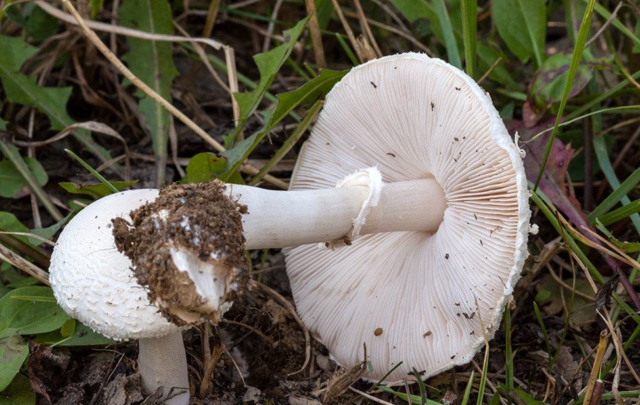
The wide-open cap and the often spaced plates on the underside make the mushrooms even more like an umbrella.
The cap of adult umbrella mushrooms can reach significant sizes - up to 35 cm in diameter. This distinctive feature significantly distinguishes them from the rest of the twins.
The surface of this type of mushroom is dry and covered with scales. With strong overgrowth, the skin cracks, forming a translucent fringe.

The surface of the cap is dry, dull, cracks during growth, becoming covered with brownish scales
Young umbrellas do not differ in color from adult mushrooms and have the same scales on the surface. But in appearance, they little resemble an umbrella, rather, a small egg on a thin stem.
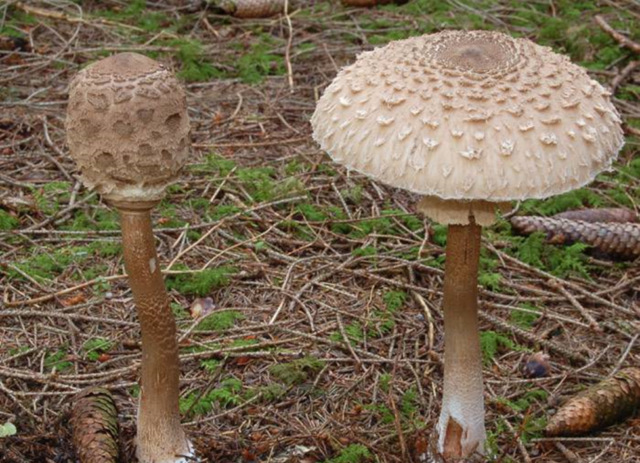
A young and an adult mushroom umbrella have a different shape of a hat.
The main difference between poisonous umbrella mushrooms is the color of the plates. In younger specimens, it may be white, but turns dark brown in adulthood.
The photo below shows the difference between the umbrella and the pale toadstool.

Plates of poisonous and real umbrellas differ in color
The color of the dots on the surface will also help determine whether the mushroom is edible or poisonous. At the umbrella, they are brown, gray or dark beige. The twins have white, with a possible shade of green.

White dots on the cap are a sign of the poisonousness of the mushroom
How to distinguish an edible umbrella from a poisonous one by the leg
The legs of a real umbrella and a poisonous twin are also different. The thickness and length of the leg are in accordance with the dimensions of the surface. The larger it is, the denser and longer the leg. It has a slight thickening at the base and a movable ring at the top.
Poisonous mushrooms can be identified by the tuberous growth at the bottom, resembling a wrapper.In real umbrellas, the stem is smooth, slightly thickened at the level of the soil and at the junction with the cap. Above the ring, the color of the leg is lighter. The rest is yellow-brown, with a scaly coating.
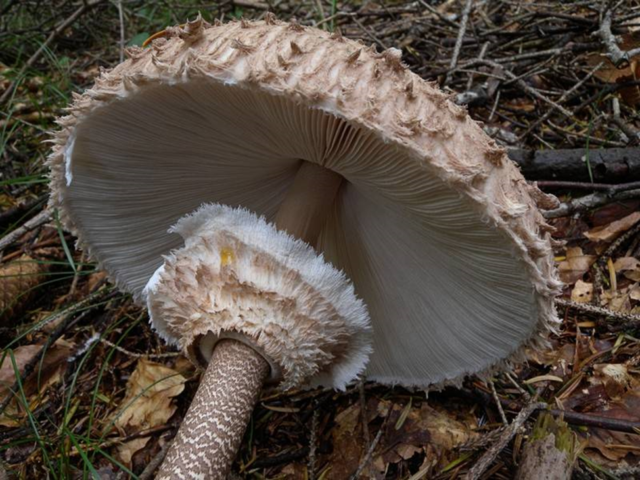
The leg of an adult umbrella has a wide fringed movable ring
When collecting umbrellas in the forest, you should be wary of those specimens whose legs are lighter, smoother and devoid of a brown pattern.

Unlike poisonous counterparts, the leg of the edible umbrella has a characteristic variegated pattern and a movable ring
How to distinguish an umbrella from a toadstool by its pulp
The flesh of edible umbrellas is light with a pleasant smell. When pressed, a clear liquid is released from it. In poisonous counterparts, the pulp has a repulsive, unpleasant smell and taste of bitterness. For example, Lepiota is rough, which in appearance is very similar to an edible umbrella, smells of pungent resin. The pulp of the white toadstool exudes a pungent smell of chlorine, which makes it possible to immediately determine its inedibility and not to be confused with a real mushroom with an umbrella.
What to do if you ate the poisonous twin of the umbrella mushroom
Poisonous twins, in addition to the listed features, are characterized by significantly smaller sizes.
You can distinguish edible mushrooms from umbrellas from poisonous ones from the video:
If it was not possible to observe caution, and the poisonous twins of the umbrella mushrooms were poisoned, it is necessary to act quickly and call a medical team when the first symptoms appear.
The implementation of the following recommendations will help to provide first aid to the poisoned person before the arrival of an ambulance:
- Activated carbon and a large amount of water will remove the products of poisoning from the body and reduce the degree of intoxication.
- Any emetics and laxatives available in the medicine cabinet will also help to cleanse the stomach and intestines. Their use should be carried out in strict accordance with the instructions.
- Elimination of alcohol intake, which accelerates the absorption of toxic substances into the bloodstream.
In case of any deterioration in well-being after eating umbrella mushrooms, you should immediately seek the help of medical staff. The consequences of the ingestion of the poison contained in the twin mushrooms into the body can be very serious, even fatal.
Tips from experienced mushroom pickers
The main rule of experienced mushroom pickers is - I'm not sure, don't take it! It is better to bring home a small harvest than to expose life and health to unjustified risks by picking mushrooms, the edibility of which has even the slightest doubt.
In order not to make a fatal mistake, before going into the forest, you should study guides, videos and photos of poisonous umbrella mushrooms with a description. Novice lovers of quiet hunting should also heed the advice of experienced mushroom pickers:
- You can put only fresh elastic specimens in the basket, bypassing old, sluggish, dried and rotten mushrooms.
- Fresh mushrooms smell like champignons, and old umbrellas starting to deteriorate take on a fishy smell.
- You cannot pick mushrooms with dark plates. This is a sign of a damaged umbrella or its poisonous counterpart.
- Do not take too small and young specimens with an unopened cap. They can be confused with inedible false umbrellas.
- When collecting representatives of this species, you should put them separately from other mushrooms so that they do not crumple or crumble.
Suspicious specimens should be left intact in the forest.
Photo of poisonous mushroom umbrellas
The variety of false doubles of umbrella mushrooms is shown in the photo:

Poisonous chlorophyllum is dark brown, fleshy and shorter, contains hallucinogenic toxin

The stinky fly agaric gives off an unpleasant chlorine odor, is characterized by the white color of the legs and cap, covered with a poisonous coating

Chlorophyllum lead-slag differs from the edible umbrella with a smooth stem with a fixed ring
Conclusion
A photo of poisonous umbrella mushrooms will help you make the right choice in the forest and harvest a tasty crop without risking your life and health.Many mushroom pickers undeservedly bypass these fruiting bodies, mistaking them for pale toadstools. The umbrella is the largest mushroom in central Russia. And, having learned to distinguish its edible species from poisonous ones, you can discover a new object of quiet hunting, characterized by a pleasant mushroom taste, aroma and impressive size.
